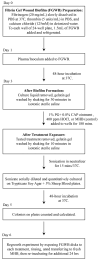The Antifungal Activity of a Polygalacturonic and Caprylic Acid Ointment in an In Vitro, Three-Dimensional Wound Biofilm Model
- PMID: 40137216
- PMCID: PMC11943374
- DOI: 10.3390/jof11030178
The Antifungal Activity of a Polygalacturonic and Caprylic Acid Ointment in an In Vitro, Three-Dimensional Wound Biofilm Model
Abstract
Candida colonization and biofilms are significant contributors to impaired wound healing. Consequently, improved treatments are needed to eradicate Candida biofilms in wounds. Wounds present complex biofilm extracellular matrix environments, with microbial cells frequently enmeshed in matrices comprising wound exudate macromolecular gels. We evaluated the ability of a polygalacturonic and caprylic acid (PG + CAP) ointment to eradicate Candida albicans, C. parapsilosis, C. glabrata, C. tropicalis, and C. auris biofilms in a fibrin gel wound biofilm model of the complex wound biofilm environment. Hypochlorous acid (HOCl) is a disinfecting antimicrobial agent that is widely used as wound irrigant, and this was used as a comparator. A single treatment with PG + CAP reduced the number of viable organisms in the C. albicans and C. glabrata biofilms by over 5 log10, in the C. parapsilosis and C. auris biofilms by over 4 log10, and in the C. tropicalis biofilm by 3.85 log10. PG + CAP was superior (p < 0.01) to HOCl in eradicating all Candida species biofilms, except for C. auris, for which both treatments fully eradicated all viable organisms. The use of HOCl in Candida-colonized wounds should include consideration of the extracellular matrix load in the wound bed. PG + CAP warrants further study in wounds compromised by Candida biofilms.
Keywords: Candida albicans; Candida auris; Candida glabrata; Candida parapsilosis; Candida tropicalis; caprylic acid; polygalacturonic acid; wound biofilm.
Conflict of interest statement
Issam Raad and Joel Rosenblatt are co-inventors of the PG + CAP technology, which is owned by The University of Texas MD Anderson Cancer Center. The other authors have no competing interests. All authors approve the submission.
Figures


Similar articles
-
Eradication of Candida auris biofilm in vitro by a polygalacturonic and caprylic acid wound ointment.J Mycol Med. 2024 Dec;34(4):101519. doi: 10.1016/j.mycmed.2024.101519. Epub 2024 Nov 5. J Mycol Med. 2024. PMID: 39549521
-
Enhanced Biofilm Eradication and Reduced Cytotoxicity of a Novel Polygalacturonic and Caprylic Acid Wound Ointment Compared with Common Antiseptic Ointments.Biomed Res Int. 2021 Feb 25;2021:2710484. doi: 10.1155/2021/2710484. eCollection 2021. Biomed Res Int. 2021. PMID: 33708989 Free PMC article.
-
Novel antimicrobial ointment for infected wound healing in an in vitro and in vivo porcine model.Wound Repair Regen. 2021 Sep;29(5):830-842. doi: 10.1111/wrr.12922. Epub 2021 May 6. Wound Repair Regen. 2021. PMID: 33956391
-
Biofilms and vulvovaginal candidiasis.Colloids Surf B Biointerfaces. 2019 Feb 1;174:110-125. doi: 10.1016/j.colsurfb.2018.11.011. Epub 2018 Nov 7. Colloids Surf B Biointerfaces. 2019. PMID: 30447520 Review.
-
Candida Biofilms: Threats, Challenges, and Promising Strategies.Front Med (Lausanne). 2018 Feb 13;5:28. doi: 10.3389/fmed.2018.00028. eCollection 2018. Front Med (Lausanne). 2018. PMID: 29487851 Free PMC article. Review.
Cited by
-
Current Overview of Environmental Disinfection and Decolonization of C. auris: A Systematic Review from 2020 to 2025.Trop Med Infect Dis. 2025 Jun 2;10(6):155. doi: 10.3390/tropicalmed10060155. Trop Med Infect Dis. 2025. PMID: 40559722 Free PMC article. Review.
References
-
- Mendoza R.A., Hsieh J.-C., Galiano R.D. Wound Healing—Current Perspectives. IntechOpen; London, UK: 2019. The impact of biofilm formation on wound healing. - DOI
-
- Malone M., Bjarnsholt T., McBain A.J., James G.A., Stoodley P., Leaper D., Tachi M., Schultz G., Swanson T., Wolcott R.D. The prevalence of biofilms in chronic wounds: A systematic review and meta-analysis of published data. J. Wound Care. 2017;26:20–25. doi: 10.12968/jowc.2017.26.1.20. - DOI - PubMed
LinkOut - more resources
Full Text Sources
Miscellaneous

